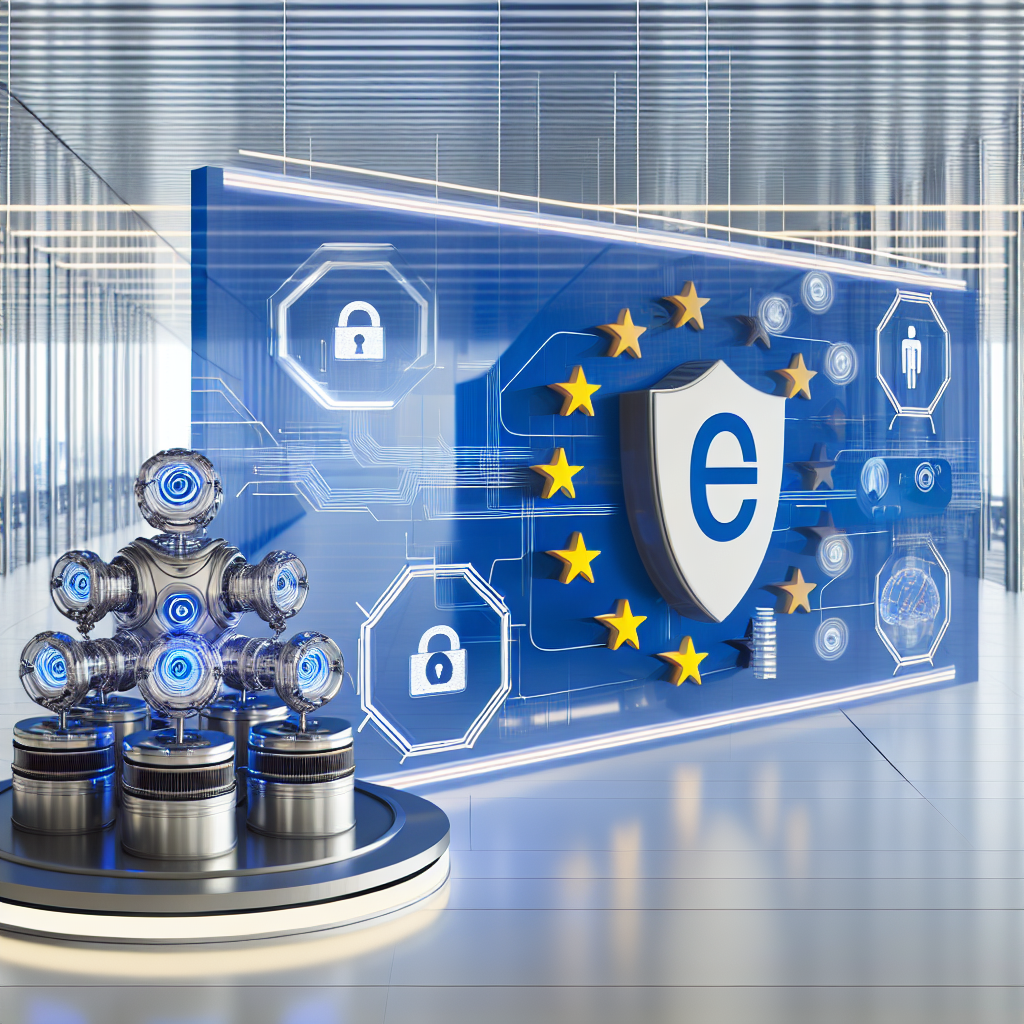# Exploring EU AI Act Compliance: 5 Essential Strategies for Managing High-Risk AI Systems in Enterprises
The EU AI Act Compliance Guide covers core requirements, risk management, governance frameworks, transparency reporting, and technical standards for high-risk AI systems, helping enterprises effortlessly meet regulatory challenges.
With the rapid advancement of AI technology, the European Union has introduced the EU AI Act to regulate the development and application of AI systems, specifically focusing on the safety and transparency of high-risk AI systems. For enterprises, understanding and implementing EU AI Act compliance is not only a legal necessity but also a path to industry leadership. How can enterprises quickly grasp compliance essentials, improve governance systems, and seamlessly align with technical standards in an increasingly stringent regulatory environment? This article dives deep into the compliance secrets guided by this policy, helping you build a forward-looking and practical AI management system.
## EU AI Act Compliance: Mastering Core Strategies for High-Risk AI Systems
The EU AI Act imposes stringent standards on high-risk AI systems. These include applications in medical, transportation, security, and recruitment sectors, among others. Such systems must undergo rigorous risk assessments and mitigation measures to protect citizens’ rights and social safety. Enterprises first need to clearly identify which algorithms, models, and applications fall under the “high-risk” category to target compliance efforts effectively.
Risk management is central. Enterprises should establish sound risk assessment processes, continuously monitor and analyze potential threats, and use approaches like data transparency, explainability, and algorithm performance verification to reduce risks. They must also ensure data quality and sample diversity to prevent algorithmic bias, minimizing negative social impacts.
Adopting international information security standards such as ISO/IEC 27001, combined with EU AI Act requirements, enterprises can design internal control mechanisms that meet regulatory demands. Regular employee training and technical audits strengthen AI system accountability and prevent compliance blind spots.
## Building an EU-Recognized AI Governance Framework to Ensure EU AI Act Compliance
Establishing a robust AI governance framework is a crucial step toward EU AI Act compliance. Enterprises need to design dedicated governance processes covering the entire AI project lifecycle — from planning, development, deployment to maintenance — all incorporating compliance considerations. Transparent governance requires clear responsibilities defined for various roles, including AI system providers, deployers, data processors, and end-users.
For instance, every link in the AI supply chain must bear corresponding obligations: providers ensure technical standards compliance and prevent security vulnerabilities; deployers oversee system operation and promptly report anomalies. Through hierarchical management, enterprises can achieve closed-loop control over the AI lifecycle, reducing operational risks.
Alongside AI governance, enterprises should establish AI ethics committees or compliance teams to regularly evaluate systems’ compliance and introduce external expert advice to improve governance quality. Support and investment from top management are indispensable to fostering a long-term compliance culture.
## Transparency Reporting and Technical Standards in EU AI Act Compliance: The Secret to Building Trust
Transparency mechanisms are particularly important under the EU AI Act compliance context. The regulation requires enterprises to submit regular transparency reports that detail AI systems’ functionalities, risk controls, performance metrics, and potential biases. This facilitates regulatory supervision and provides the public and users with sufficient information, enhancing trust.
To prepare compliant transparency reports, enterprises can formulate internal templates, combine them with audit results, and emphasize algorithm explainability and data protection. Using leading document management tools ensures completeness and traceability of information.
In addition, implementing technical standards such as ISO/IEC JTC 1/SC 42 (International AI Standards) not only assists in completing EU AI Act certification processes but also provides a solid technical foundation for robust compliance. AI products conforming to these standards are more likely to gain market recognition and promote cross-border cooperation and expansion.
## 5-Step Easy Certification of High-Risk AI Systems: A Technical Journey to EU AI Act Compliance
Certification is the ultimate goal of EU AI Act compliance. High-risk AI systems require CE marking certification, the European market access mark. The certification pathway usually involves preparing technical documentation, demonstrating risk management, and undergoing independent third-party testing.
Enterprises are advised to develop phased compliance certification plans in advance, carrying out technology evaluations and testing step-by-step. Leveraging automation tools, such as Microsoft Purview compliance management, Content Safety monitoring, and PyRIT security auditing, can significantly improve efficiency and accuracy.
Furthermore, certified systems must maintain ongoing compliance: designing automatic alert mechanisms and providing real-time feedback on compliance status to enable proactive prevention and corrective actions. This approach ensures sustainable and robust adherence to regulations in dynamic environments.
## Future-Oriented EU AI Act Compliance: Comprehensive Protection for General-Purpose AI Models
With the rise of General-Purpose AI models (GPAI), legislation continuously evolves to address emerging risks. These general models, due to their wide applicability and powerful capabilities, bring more complex ethical and security challenges.
EU AI Act compliance emphasizes lifecycle management — covering full-chain oversight from model training, testing, deployment to monitoring. Quality control of training data and bias detection are crucial, alongside strengthening model update security and auditability to prevent misuse.
Enterprises should integrate industry codes of practice, maintain close cooperation with AI offices and standardization bodies to stay updated on compliance guidance. Implementing complete compliance closed-loop management not only ensures policy enforcement but also drives innovation and safety in parallel.
## Best Compliance Tools and Collaboration Tips to Help Enterprises Quickly Meet EU AI Act Standards
In practice, mastering suitable and efficient compliance tools is a “secret weapon” for speeding up EU AI Act compliance completion. Automation platforms like Microsoft Purview help enterprises track compliance metrics, automatically generate risk reports and analyses. Content Safety tools focus on AI content security to prevent illegal information spread.
Additionally, PyRIT technical review systems facilitate identifying and fixing security vulnerabilities, ensuring stable AI system operation. Enterprises should also actively enhance internal and external collaboration, communicate closely with AI offices, participate in industry standards organizations, and share best practices to broaden compliance perspectives and capabilities.
By flexibly leveraging these tools and collaborations, enterprises can stay aligned with regulatory trends, continuously optimize governance frameworks, and steadily improve compliance efficiency and competitiveness.
—
### Frequently Asked Questions
**What types of AI systems does EU AI Act compliance primarily apply to?**
High-risk AI systems, especially those involving personal safety, data protection, employment, transportation, medical care, and public services, must meet EU AI Act compliance requirements.
**How can enterprises effectively manage risks to comply with the EU AI Act?**
By continuous risk assessments, data quality management, algorithm testing and optimization, and establishing risk mitigation strategies to ensure AI system safety and reliability.
**How important are transparency reports in EU AI Act compliance?**
Transparency reports enhance AI system credibility, fulfill regulatory demands, and help users and the public understand AI system operations and safety guarantees.
**What is the CE marking certification for high-risk AI systems?**
It is the EU market access mark issued to products meeting safety and compliance requirements, signifying systems have passed rigorous review and management.
**What compliance challenges do General-Purpose AI models (GPAI) face?**
Complex system risks, training data diversity, stringent model testing, ongoing monitoring, and version control are key challenges.
**How can enterprises use automation tools to enhance EU AI Act compliance efficiency?**
Through automated risk assessment, compliance tracking, and data security monitoring tools, enterprises can reduce human errors and accelerate compliance responses.
—
**Conclusion**
Achieving EU AI Act compliance is a crucial step for modern enterprises embracing responsible AI. Understanding regulatory background, building comprehensive governance, proactively disclosing transparent information, and integrating top industry standards and tools will position enterprises firmly atop the regulatory landscape and secure future competitive advantages. If you are preparing to tackle the challenges brought by the EU AI Act, feel free to visit [De-Line Technology](https://www.de-line.net) for more professional compliance service solutions. Let us help your enterprise easily meet regulatory challenges and co-create an intelligent future! 🚀🤖
************
The above content is provided by our AI automation poster


